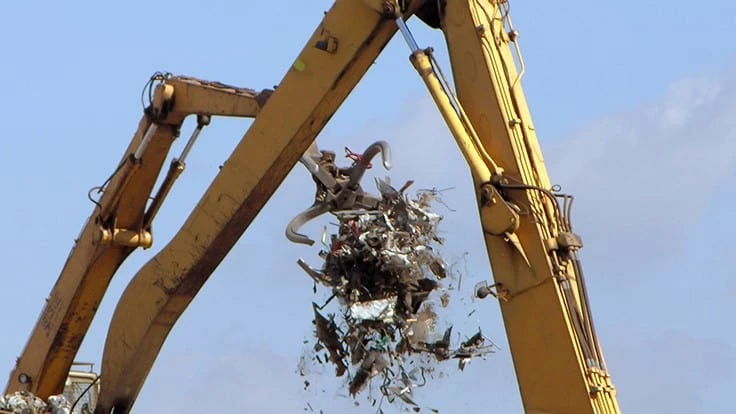
Photo provided by Dreamstime.
The high per-ton prices that have characterized the ferrous scrap market in the first trimester of 2021 may be here for a while longer, panelists at an online industry session speculated in mid-April.
The 70 percent market share for scrap-fed electric arc furnace (EAF) technology in the United States is a key reason for the prediction, according to the panelists at the session held by Fastmarkets AMM titled “Steel market dynamics and raw material demand in the United States.”
Alan Kestenbaum, CEO of Hamilton, Ontario-based steelmaker Stelco, said demand for steel from North American producers is strong during the rebound from COVID-19 and its restrictions.
He said the fact that EAFs now have 70 percent of the market means they increasingly dictate steel prices in North America, and high scrap prices thus likewise lead to higher steel pricing. “The [strained supply] raw material situation, which is what drives price in North America, is real,” said Kestenbaum. “It’s something that can be seen, it’s happening and it’s going to get more acute.”
Kestenbaum pointed to the export market and potential increased buying from China as another factor that could prolong the bull market for scrap, as did two of his fellow panelists, one of them from the scrap processing sector.
“Now that China has come back into the market again, you’re seeing demand outweigh supply,” said Sean Daoud, a vice president with Clackamas, Oregon-based PNW Metal Recycling. “I think, as their regulations develop, they are going to come into this market and buy a lot of ferrous scrap to feed their EAFs.”
Jeffrey Lorch, a partner with consultancy McKinsey, said European mill buyers may also develop a wider global presence, as the European Union and national governments there enact decarbonization policies that will favor the melting of scrap over other iron units.
On the supply side, CEO Allan Goldstein of Pittsburgh-based scrap processing and trading firm AMG Resources said of prompt scrap—currently enjoying a wide price premium over obsolete scrap—“No matter what price you put on that scrap, you’re not putting more of it out—only so much is produced.”
He said the supply of obsolete grades has risen with the increase in prices, but some of this scrap is not favored by domestic steel buyers. “People forget that the U.S. does export around 18 million tons per year of ferrous scrap. A lot of that can’t be used by domestic steelmakers.” Goldstein added, “Then again, there is shred and P&S [plate and structural] being exported, so there is a little bit of a reservoir there” that could go to domestic mills.
Daoud characterized the current state of supply on the West Coast as tight, saying lockdown restrictions in all three Pacific Coast states during COVID had pinched supply. As of April, “More demolition work is going on now, so that scrap supply is going back up.”
Lorch of McKinsey expressed long-term bullishness for scrap, portraying the low-carbon aspects of the material as meaning “scrap is going to move from 30 to 50 percent of total metal units in the market by 2045. As a result of that, never bet against scrap.”
Despite all the signs of bullishness, Goldstein quipped, “I’ve been in the business over 40 years. Every time the scrap market goes high, it’s a paradigm shift. And then three years later, I can’t sell my scrap.” He added, “I think the market will come down eventually. I wish it wouldn’t, but it will. I’m selling my scrap, not holding it. So, the next conference [topic might be] ‘When will the market perk up?’” Shifting back to optimism, he concluded, “It is always a gradual shift for the better, and I think it will continue.”
Session moderator Vince Pappalardo of investment banking firm Brown Gibbons Lang & Co. LLC also asked panelists about the emphasis on ferrous scrap quality and chemistry in 2021. Goldstein commented, “At AMG we guarantee chemistries. On our shredders we use smaller grates so we can separate better. We use a lot of technology, and that will continue so you’ll see higher grades coming about and you’ll see steel mills being able to blend in the lower grades to produce their heats. It’s a huge capital expense, [and] by the time we put a new piece of equipment in, it’s almost obsolete. But that’s how mills can use more scrap—when they can be guaranteed of the chemistries. When you can guarantee the chemistries, you’ll always have better sales.”
Daoud said, “Quality standards are almost par at this point all over the world,” with processors increasingly working with equipment vendors to use “sensors in your ferrous sorting equipment to take the copper and impurities out of your steel shred.”
Latest from Recycling Today
- Aqua Metals secures $1.5M loan, reports operational strides
- AF&PA urges veto of NY bill
- Aluminum Association includes recycling among 2025 policy priorities
- AISI applauds waterways spending bill
- Lux Research questions hydrogen’s transportation role
- Sonoco selling thermoformed, flexible packaging business to Toppan for $1.8B
- ReMA offers Superfund informational reports
- Hyster-Yale commits to US production





